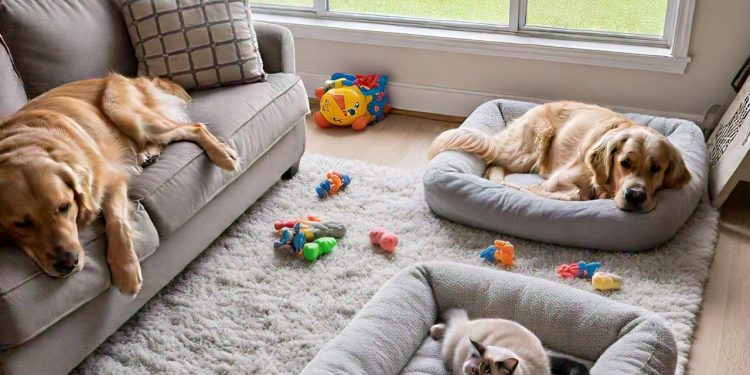Creating a pet-friendly home environment is essential for ensuring your furry companion feels safe, comfortable, and loved. Whether you’re a first-time pet owner or a seasoned pet parent, understanding how to design your living space to accommodate your pet’s needs can improve their quality of life and reduce potential stressors. This guide will provide a step-by-step breakdown of how to manifest a home that is not only pet-friendly but also functional for you and your family.
Why a Pet-Friendly Home Environment Matters
A thoughtfully designed pet-friendly home benefits both pets and owners.
- Promotes Well-being: Pets thrive in spaces that cater to their physical and emotional needs.
- Minimizes Destruction: Proper organization reduces the likelihood of chewed furniture or scratched floors.
- Improves Safety: A pet-friendly home eliminates hazards like exposed wires or toxic plants.
- Enhances Bonding: Pets feel more relaxed and secure in a space designed with them in mind.
Key Considerations When Creating a Pet-Friendly Home
1. Safety First
The cornerstone of a pet-friendly home is safety. Common household items can pose risks to pets if not addressed.
- Secure Cords and Wires: Use cord protectors or hide wires to prevent chewing.
- Lock Away Hazardous Items: Store cleaning products, medications, and sharp objects in pet-proof cabinets.
- Choose Non-Toxic Plants: Avoid plants like lilies, pothos, and sago palms, which can be harmful to pets.
2. Flooring Choices
Your flooring needs to withstand the wear and tear of claws, accidents, and spills.
- Pet-Friendly Options: Opt for durable, scratch-resistant materials like vinyl, laminate, or tile.
- Area Rugs: Use machine-washable rugs for added comfort while protecting floors.
3. Designated Zones for Your Pet
Creating dedicated spaces for your pet ensures they have a spot to relax, eat, and play.
- Sleeping Area: Provide a cozy bed or crate in a quiet part of the house.
- Feeding Station: Set up food and water bowls in a location away from foot traffic.
- Play Zone: Include interactive toys and scratching posts to keep your pet entertained.
Tips for Designing Specific Areas of Your Home
Living Room
- Furniture: Choose stain-resistant, easy-to-clean upholstery like leather or microfiber.
- Decor: Avoid fragile items on low shelves or tables.
- Pet Access: Provide ramps or steps for pets to access furniture safely.
Kitchen and Dining Areas
- Food Storage: Use airtight containers to keep pet food fresh and prevent spills.
- Trash Cans: Invest in a pet-proof trash can to avoid messes.
- Flooring: Opt for non-slip mats near feeding areas to prevent sliding bowls.
Bedrooms
- Bedding: Use pet-friendly bed covers that are machine-washable.
- Closets: Keep closet doors closed to prevent pets from chewing on shoes or clothing.
Outdoor Spaces
- Fencing: Ensure fences are secure and high enough to prevent escapes.
- Safe Plants: Research pet-friendly landscaping options like lavender, marigolds, and sunflowers.
- Shade and Shelter: Provide shaded areas and water bowls during hot weather.
Enhancing Comfort and Stimulation for Your Pet
1. Mental Enrichment
Mental stimulation is crucial for reducing boredom and destructive behaviors.
- Interactive Toys: Puzzle feeders, treat-dispensing balls, and snuffle mats are excellent choices.
- Window Perches: Cats love watching the outdoors, so consider adding a perch near a window.
2. Physical Comfort
Make your home a haven of comfort for your pet.
- Bedding: Choose orthopedic beds for older pets or memory foam mats for added support.
- Climate Control: Ensure your home maintains a pet-friendly temperature, especially during extreme weather.
3. Noise Reduction
Loud noises can stress pets.
- Soundproofing: Use rugs, curtains, and upholstered furniture to absorb sound.
- White Noise Machines: These can calm pets during thunderstorms or fireworks.
Pet-Friendly Décor Tips
- Washable Fabrics: Choose washable slipcovers, curtains, and rugs.
- Dark Colors and Patterns: These help hide fur and stains.
- Scratch-Resistant Surfaces: Use furniture with scratch-resistant finishes.
Training and Behavior Management in Your Home
A pet-friendly home also involves managing your pet’s behavior to minimize accidents or destruction.
- Litter Training: Provide a clean, easily accessible litter box for cats.
- Housebreaking: Use puppy pads or regular outdoor breaks to train dogs.
- Behavioral Aids: Use deterrent sprays or protective covers to discourage chewing or scratching.
Sustainability and Eco-Friendly Options
Creating a pet-friendly home doesn’t have to harm the environment.
- Recycled Materials: Look for pet beds, toys, and accessories made from recycled materials.
- Biodegradable Waste Bags: These are great for cleaning up after your dog.
- Non-Toxic Cleaning Products: Use pet-safe cleaning supplies to maintain a healthy environment.
FAQs About Pet-Friendly Homes
Q: What’s the best way to pet-proof a home?
A: Start by removing or securing hazardous items, creating designated pet zones, and choosing durable materials for furniture and flooring.
Q: How can I manage pet odors?
A: Use washable fabrics, air purifiers, and enzymatic cleaners for effective odor control.
Q: Can a pet-friendly home also be stylish?
A: Absolutely! Opt for sleek, durable furniture and use décor that complements your pet’s needs without sacrificing aesthetics.
Conclusion
Manifesting a pet-friendly home environment is about balancing your pet’s needs with your lifestyle. By implementing safety measures, creating comfortable spaces, and enriching their environment, you’ll not only enhance your pet’s happiness but also ensure harmony within your home.
Start transforming your space today, and enjoy the rewards of a well-adjusted, joyful pet in a home designed just for them!

























